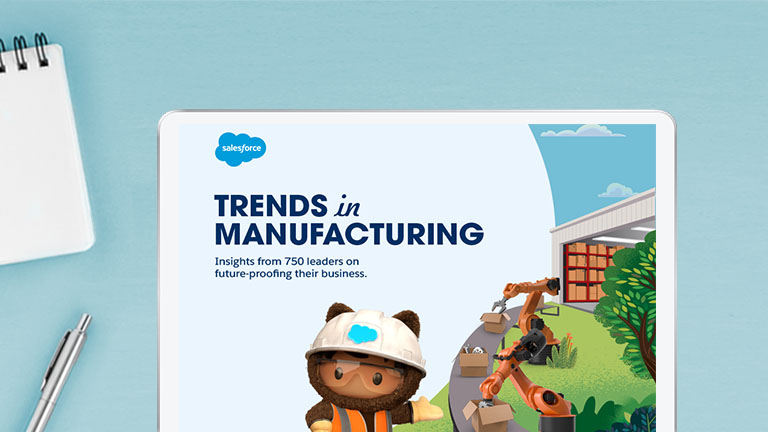Supply chain management (SCM) refers to the planning, control, and execution of the flow of goods — from materials to final products.
There are five key components to supply chain management:
-
Planning
-
Sourcing
-
Manufacturing
-
Delivery and logistics
-
Returning
SCM is an integral part of the manufacturing industry. And it’s also important for any product-based business which has a supply chain.
In this article, we’ll explain why SCM is important for different businesses, outline a digital supply chain, and list the five stages of SCM in more detail.
Trends in Manufacturing
Salesforce Industry Insights surveyed 750 manufacturers worldwide. Download this report to discover more.

Why is SCM important for businesses?
Supply chain management is important because it can increase efficiency and reduce costs. This increases profits.
Elements of SCM are already in place for most businesses, but it’s not always treated as an end-to-end process. SCM brings all parts together and this is what results in greater benefits.
Connecting each part of the supply chain can bring lots of advantages, including:
Better product quality
Controlling manufacturing processes can improve product quality. By monitoring the supply chain at every stage, issues can be identified before faulty products go to market. This reduces the risk of product recalls and protects the brand’s reputation.
Improved customer satisfaction
Supply chain management can help you to serve your customers better with the goods that they want. This is because you can avoid stock shortages and periods of inventory oversupply with SCM. By using SCM, you can always have the right amount of stock to meet demand and keep customers happy.
Faster identification of issues
With SCM, every stage of the supply chain is connected. So if there’s a problem, you’ll be able to address it. With SCM, there is better collaboration across the supply chain so issues can be identified and resolved quickly.
What is a digital supply chain?
As with many business processes, supply chain management is now often done digitally.
A digital supply chain takes supply chain management to the next level and can maximise efficiency.
A traditional supply chain looks at each stage in a linear way. It may also be limited if there is a lack of integration between parts. Whereas a digital supply chain views the supply chain as a network. This means you can respond to problems in real-time so you don’t need to wait for one part of the supply chain to hand over to the next.
One of the main benefits of digitalising your SCM is that it improves visibility.
Five steps in digital SCM
Digital can feed into each step of SCM. Digitalisation improves collaboration across the supply chain. All stakeholders can communicate more freely and share up-to-date information. Digitalisation also increases efficiency within each element.
The five parts of the supply chain that SCM connects are:
1. Planning
The planning stage is where a business plans all the resources needed across the supply chain. It’s important that customer demands are understood fully at this stage. An integrated CRM system can also be used to help planners know what customers need. Using a connected, digital SCM process will allow every relevant person to be involved and oversee the planning stage. An SCM can also be used to monitor the efficiency of the supply chain, which can improve how you plan the next project.
2. Sourcing
Sourcing is when you choose the supplier who will provide the goods and services needed to create the product. This stage may include activities such as ordering, receiving, and managing inventory and authorising supplier payments. All of these elements can be made more efficient with digital software.
In today’s climate, improving sourcing is more important than ever. Fewer workers and raw material shortages are leading to stock shortages and rising costs of goods and services. Using your SCM to monitor and manage supplier relationships is vital in this competitive environment.
3. Manufacturing
The manufacturing part of the supply chain is when products are created. This involves accepting raw materials, manufacturing, quality testing, and packaging items. SCM allows all stakeholders to understand the progress manufacturers are making in real-time. Knowing the speed of manufacturing helps businesses know when stock will be ready to sell.
4. Delivery and logistics
Logistics involves coordinating customer orders, scheduling deliveries, and dispatching goods. This part also includes invoicing customers and receiving payments. Higher demand, HGV driver shortages, and increased container costs are affecting this stage. An SCM can help you to track the impact these issues have on the supply chain.
Delivery is where the supply chain meets with customers. That’s why integrating your SCM with your customer relationship management (CRM) system can be beneficial. The integration allows customer information to pass between systems. Connecting your SCM to your CRM means you can update customers with the delivery process and timelines, which supports a better customer journey.
5. Returns process
The returns process is used to manage customers returning faulty or unwanted products. SCM can help identify issues such as goods that are frequently returned and might be being manufactured incorrectly.
The returns process is another part of the supply chain process that works best when integrated with a CRM. This will lead to a smoother returns experience for customers.
Salesforce can support SCM – and its challenges
Salesforce products can be used to support SCM and resolve challenges across the supply chain.
With Salesforce Commerce Cloud and Service Cloud, you can:
-
Better manage merchandise sell-through, optimise inventory and preserve funds
-
Provide inventory visibility and nurture out-of-stock across your business
-
Accept pre-orders ahead of the shopping season for easier demand planning
Plus, by connecting an SCM with Salesforce’s Customer 360 CRM, you can have a 360-degree view of every customer — at each stage of the supply chain.
Trends in Manufacturing
Salesforce Industry Insights surveyed 750 manufacturers worldwide. Download this report to discover more.






















